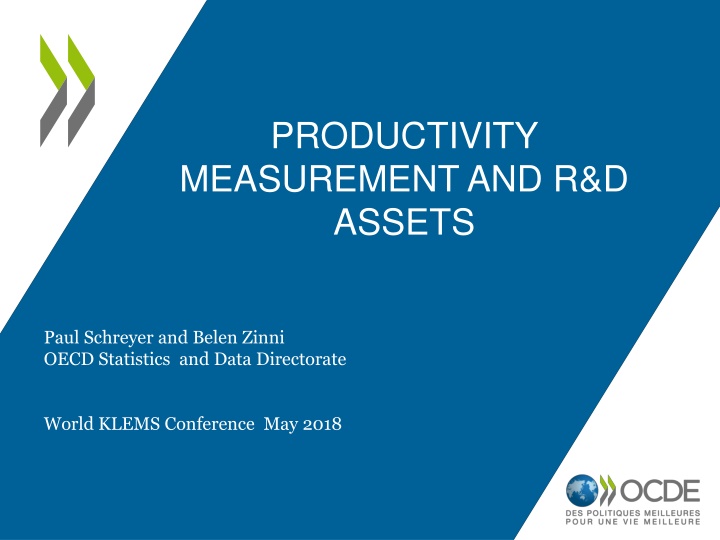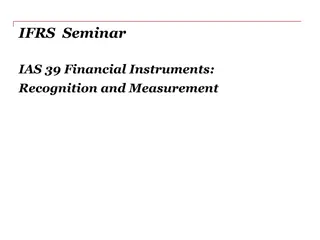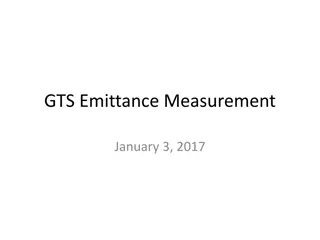Measurement and Analysis of R&D Assets for Productivity Enhancement
Delve into the intricate relationship between productivity measurement and R&D assets, exploring the challenges of capitalizing R&D expenditures and the implications for economic analysis. Dive into the complexities of measuring the impact of R&D as a shifter in cost functions, and consider the nuances of incorporating shadow prices for R&D in productivity analysis. Gain insights into the critical policy implications of demand dynamics and market size on productivity growth and the need for a comprehensive approach to understanding productivity trends.
Download Presentation

Please find below an Image/Link to download the presentation.
The content on the website is provided AS IS for your information and personal use only. It may not be sold, licensed, or shared on other websites without obtaining consent from the author.If you encounter any issues during the download, it is possible that the publisher has removed the file from their server.
You are allowed to download the files provided on this website for personal or commercial use, subject to the condition that they are used lawfully. All files are the property of their respective owners.
The content on the website is provided AS IS for your information and personal use only. It may not be sold, licensed, or shared on other websites without obtaining consent from the author.
E N D
Presentation Transcript
PRODUCTIVITY MEASUREMENT AND R&D ASSETS Paul Schreyer and Belen Zinni OECD Statistics and Data Directorate World KLEMS Conference May 2018
SNA 2008: R&D capitalisation Added source of capital services Is R&D special? Shifter rather than individual contributor Upfront investments, non-constant returns, mark-ups Hard to measure
R&D as a shifter Restricted cost function
Productivity measurement with a shadow price for R&D Problems: endogeneity and errors in variables
no strong arguments for econometric measure of shadow price for R&D Cost-elasticities of R&D: distribution of unrestricted measures and econometric results
but returns to scale are retained Direct and reverse estimates Various combinations of fixed effects for countries and years 12 results between 0.8 and 1.6 We settle for geometric average *=1.2 In line with Diewert and Fox (2008), Basu and Fernald (1997)
both effects are important Scale effects and residual MFP, Average annual percentage change, 1985-2015 Source: authors calculations, based on OECD Productivity Database October 2017.
policy relevance Effect of demand on productivity longer-term demand effects (eg from rising income inequality and declining average propensity to consume (Summers 2015) or precautionary savings by low incomes (Auclert and Rognlie 2018) Short term procyclical nature of productivity growth Basu and Fernald (1997) Market size matters for MFP: positive effects of expanding trade and vice versa Increasing returns to scale imply the existence of mark- ups over marginal costs relevant for competition policy?
mark-ups over marginal costs M*t = nominal value of output at basic prices minus labour compensation minus user costs of capital Average mark-up factor 1+m*t, across all countries and years is around 1.3 or a 30% addition to marginal costs Possible reasons: Need to cover average costs Pure rents Unmeasured inputs (KBC) R&D services from headquarters Under-stated returns to measured capital .
have been rising nearly everywhere Mark-ups over marginal costs 1Ireland, New Zealand, Portugal and Spain: 2014 Source: authors calculations, based on OECD Productivity Database October 2017.
In conclusion R&D capital stock measures now widely available in OECD countries Measurement of R&D capital services more complicated than other assets, and potentially R&D has a different role in production Established index number approach still appears to be the most sensible way Evidence for moderately increasing returns at the aggregate economy level This implies effect from output and demand on MFP The dual picture is mark-ups over marginal costs that have trended upwards This chimes well with effects of globalisation and digitalisation but other causes possible as well.
Updated version of the paper with latest data from the OECD Productivity Compendium forthcoming Thank you!























